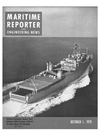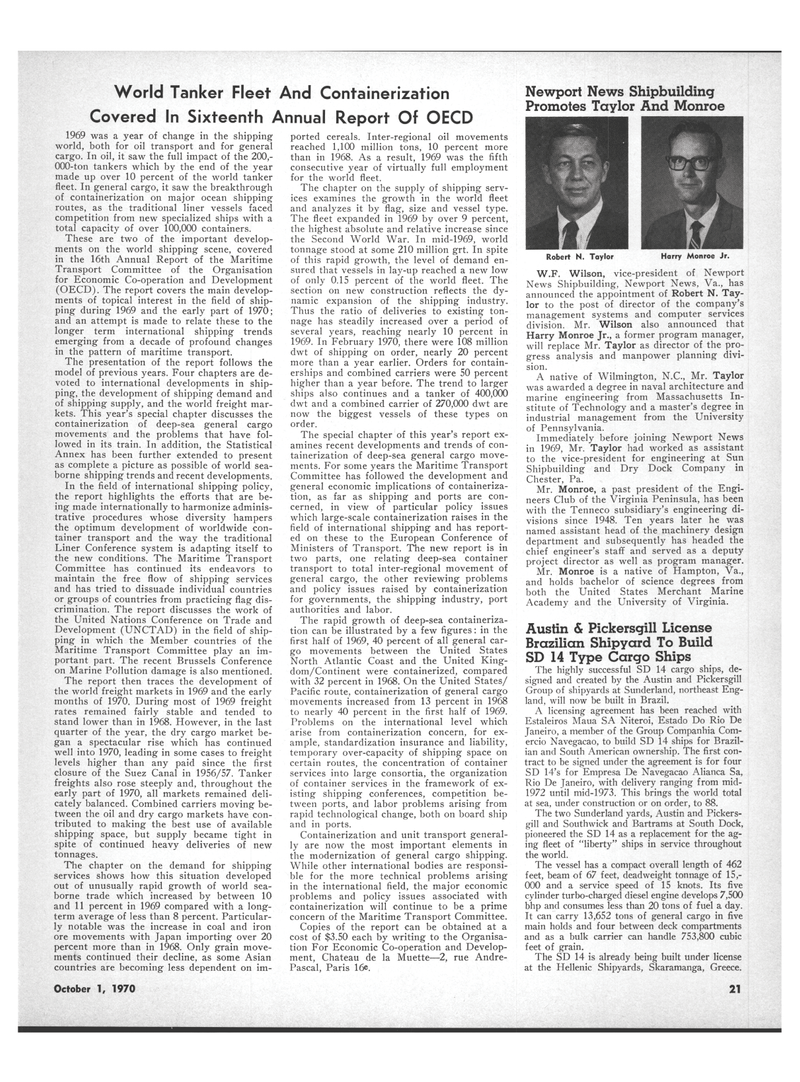
Page 19: of Maritime Reporter Magazine (October 1970)
Read this page in Pdf, Flash or Html5 edition of October 1970 Maritime Reporter Magazine
Newport News Shipbuilding
Promotes Taylor And Monroe
World Tanker Fleet And Containerization
Covered In Sixteenth Annual Report Of OECD 1969 was a year of change in the shipping world, both for oil transport and for general cargo. In oil, it saw the full impact of the 200,- 000-ton tankers which by the end of the year made up over 10 percent of the world tanker fleet. In general cargo, it saw the breakthrough of containerization on major ocean shipping routes, as the traditional liner vessels faced competition from new specialized ships with a total capacity of over 100,000 containers.
These are two of the important develop- ments on the world shipping scene, covered in the 16th Annual Report of the Maritime
Transport Committee of the Organisation for Economic Co-operation and Development (OECD). The report covers the main develop- ments of topical interest in the field of ship- ping during 1969 and the early part of 1970; and an attempt is made to relate these to the longer term international shipping trends emerging from a decade of profound changes in the pattern of maritime transport.
The presentation of the report follows the model of previous years. Four chapters are de- voted to international developments in ship- ping, the development of shipping demand and of shipping supply, and the world freight mar- kets. This year's special chapter discusses the containerization of deep-sea general cargo movements and the problems that have fol- lowed in its train. In addition, the Statistical
Annex has been further extended to present as complete a picture as possible of world sea- borne shipping trends and recent developments.
In the field of international shipping policy, the report highlights the efforts that are be- ing made internationally to harmonize adminis- trative procedures whose diversity hampers the optimum development of worldwide con- tainer transport and the way the traditional
Liner Conference system is adapting itself to the new conditions. The Maritime Transport
Committee has continued its endeavors to maintain the free flow of shipping services and has tried to dissuade individual countries or groups of countries from practicing flag dis- crimination. The report discusses the work of the United Nations Conference on Trade and
Development (UNCTAD) in the field of ship- ping in which the Member countries of the
Maritime Transport Committee play an im- portant part. The recent Brussels Conference on Marine Pollution damage is also mentioned.
The report then traces the development of the world freight markets in 1969 and the early months of 1970. During most of 1969 freight rates remained fairly stable and tended to stand lower than in 1968. However, in the last quarter of the year, the dry cargo market be- gan a spectacular rise which has continued well into 1970, leading in some cases to freight levels higher than any paid since the first closure of the Suez Canal in 1956/57. Tanker freights also rose steeply and, throughout the early part of 1970, all markets remained deli- cately balanced. Combined carriers moving be- tween the oil and dry cargo markets have con- tributed to making the best use of available shipping space, but supply became tight in spite of continued heavy deliveries of new tonnages.
The chapter on the demand for shipping services shows how this situation developed out of unusually rapid growth of world sea- borne trade which increased by between 10 and 11 percent in 1969 compared with a long- term average of less than 8 percent. Particular- ly notable was the increase in coal and iron ore movements with Japan importing over 20 percent more than in 1968. Only grain move- ments continued their decline, as some Asian countries are becoming less dependent on im- ported cereals. Inter-regional oil movements reached 1,100 million tons, 10 percent more than in 1968. As a result, 1969 was the fifth consecutive year of virtually full employment for the world fleet.
The chapter on the supply of shipping serv- ices examines the growth in the world fleet and analyzes it by flag, size and vessel type.
The fleet expanded in 1969 by over 9 percent, the highest absolute and relative increase since the Second World War. In mid-1969, world tonnage stood at some 210 million grt. In spite of this rapid growth, the level of demand en- sured that vessels in lay-up reached a new low of only 0.15 percent of the world fleet. The section on new construction reflects the dy- namic expansion of the shipping industry.
Thus the ratio of deliveries to existing ton- nage has steadily increased over a period of several years, reaching nearly 10 percent in 1969. In February 1970, there were 108 million dwt of shipping on order, nearly 20 percent more than a year earlier. Orders for contain- erships and combined carriers were 50 percent higher than a year before. The trend to larger ships also continues and a tanker of 400,000 dwt and a combined carrier of 270,000 dwt are now the biggest vessels of these types on order.
The special chapter of this year's report ex- amines recent developments and trends of con- tainerization of deep-sea general cargo move- ments. For some years the Maritime Transport
Committee has followed the development and general economic implications of containeriza- tion, as far as shipping and ports are con- cerned, in view of particular policy issues which large-scale containerization raises in the field of international shipping and has report- ed on these to the European Conference of
Ministers of Transport. The new report is in two parts, one relating deep-sea container transport to total inter-regional movement of general cargo, the other reviewing problems and policy issues raised by containerization for governments, the shipping industry, port authorities and labor.
The rapid growth of deep-sea containeriza- tion can be illustrated by a few figures: in the first half of 1969, 40 percent of all general car- go movements between the United States
North Atlantic Coast and the United King- dom/Continent were containerized, compared with 32 percent in 1968. On the United States/
Pacific route, containerization of general cargo movements increased from 13 percent in 1968 to nearly 40 percent in the first half of 1969.
Problems on the international level which arise from containerization concern, for ex- ample, standardization insurance and liability, temporary over-capacity of shipping space on certain routes, the concentration of container services into large consortia, the organization of container services in the framework of ex- isting shipping conferences, competition be- tween ports, and labor problems arising from rapid technological change, both on board ship and in ports.
Containerization and unit transport general- ly are now the most important elements in the modernization of general cargo shipping.
While other international bodies are responsi- ble for the more technical problems arising in the international field, the major economic problems and policy issues associated with containerization will continue to be a prime concern of the Maritime Transport Committee.
Copies of the report can be obtained at a cost of $3.50 each by writing to the Organisa- tion For Economic Co-operation and Develop- ment, Chateau de la Muette—2, rue Andre-
Pascal, Paris 16e.
Robert N. Taylor Harry Monroe Jr.
W.F. Wilson, vice-president of Newport
News Shipbuilding, Newport News, Va., has announced the appointment of Robert N. Tay- lor to the post of director of the company's management systems and computer services division. Mr. Wilson also announced that
Harry Monroe Jr., a former program manager, will replace Mr. Taylor as director of the pro- gress analysis and manpower planning divi- sion.
A native of Wilmington, N.C., Mr. Taylor was awarded a degree in naval architecture and marine engineering from Massachusetts In- stitute of Technology and a master's degree in industrial management from the University of Pennsylvania.
Immediately before joining Newport News in 1969, Mr. Taylor had worked as assistant to the vice-president for engineering at Sun
Shipbuilding and Dry Dock Company in
Chester, Pa.
Mr. Monroe, a past president of the Engi- neers Club of the Virginia Peninsula, has been with the Tenneco subsidiary's engineering di- visions since 1948. Ten years later he was named assistant head of the machinery design department and subsequently has headed the chief engineer's staff and served as a deputy project director as well as program manager.
Mr. Monroe is a native of Hampton, Va., and holds bachelor of science degrees from both the United States Merchant Marine
Academy and the University of Virginia.
Austin & Pickersgill License
Brazilian Shipyard To Build
SD 14 Type Cargo Ships
The highly successful SD 14 cargo ships, de- signed and created by the Austin and Pickersgill
Group of shipyards at Sunderland, northeast Eng- land, will now be built in Brazil.
A licensing agreement has been reached with
Estaleiros Maua SA Niteroi, Estado Do Rio De
Janeiro, a member of the Group Companhia Com- ercio Navegacao, to build SD 14 ships for Brazil- ian and South American ownership. The first con- tract to be signed under the agreement is for four
SD 14's for Empresa De Navegacao Alianca Sa,
Rio De Janeiro, with delivery ranging from mid- 1972 until mid-1973. This brings the world total at sea, under construction or on order, to 88.
The two Sunderland yards, Austin and Pickers- gill and Southwick and Bartrams at South Dock, pioneered the SD 14 as a replacement for the ag- ing fleet of "liberty" ships in service throughout the world.
The vessel has a compact overall length of 462 feet, beam of 67 feet, deadweight tonnage of 15,- 000 and a service speed of 15 knots. Its five cylinder turbo-charged diesel engine develops 7,500 bhp and consumes less than 20 tons of fuel a day.
It can carry 13,652 tons of general cargo in five main holds and four between deck compartments and as a bulk carrier can handle 753,800 cubic feet of grain.
The SD 14 is already being built under license at the Hellenic Shipyards, Skaramanga, Greece.
October 1, 1770 21

 18
18

 20
20
